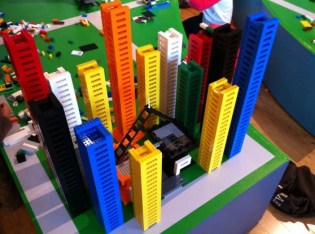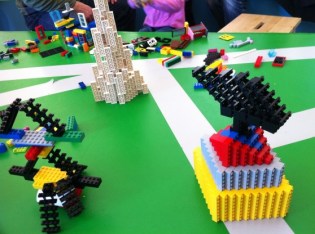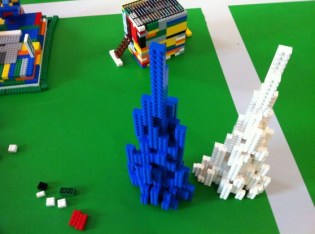 Cross-posted from LAB|Log.
Cross-posted from LAB|Log.
One evening about a year ago, staff members at the National Building Museum in Washington, D.C., did something a bit unusual as they prepared to close the LEGO building area for the evening. Charmed by its simple beauty, they spared a rather handsome yellow pyramid created by one of the museum’s visitors from their ruthlessly thorough daily LEGO disassembly process. Instead of completely “wiping the slate clean” for the next day’s visitors, on this evening they broke with tradition and positioned the pyramid in a prominent place in the building area.
Not long after the museum’s opening the next morning, I shuffled into the LEGO room. It was filled with the typical assortment of visitors, happily building … pyramids, in every imaginable shape, size, and color. In fact, the room was beginning to positively overflow with them.
Walk into the LEGO “free-play” building area at the Building Museum on any given day, and you will see a room filled with people of all ages and backgrounds, eagerly building away. Many of these people — architecture students, 10-year-olds, grandfathers with their grandchildren, tourists — spend entire Saturdays in this room, building things.
With thousands upon thousands of LEGOs, consistently diverse groups of people, and scores of posters challenging you to build the various pieces of architecture that comprise our cities, it seems probable that the room would be a sea of creativity. And yet on most days, instead of a sweeping diversity of creations, one building pattern or formal expression completely dominates. Sometimes the room is jam-packed with towers; on other occasions by houses, animals, or people’s names spelled with LEGOs.
Despite this regular conformity, it is always possible to find a few individuals — of no consistent age or background — doing something completely different from everyone else. Their creative motivations became one of the focal points of my research during my Field Fellowship last year at the Building Museum.
 In many ways, their “outlier” creations appear to be the epitome of how we typically conceive of creativity, often completely challenging the basic rules dictated by the general form of the LEGO. However, curiously, while they couldn’t always point out their inspiration, every single “outlier” claimed that they were simply expanding on some combination of LEGO pieces that they had seen elsewhere in the room. Even the most “creative” people in the room began, like their tower-building brethren, by copying something or mimicking someone in their general visual proximity.
In many ways, their “outlier” creations appear to be the epitome of how we typically conceive of creativity, often completely challenging the basic rules dictated by the general form of the LEGO. However, curiously, while they couldn’t always point out their inspiration, every single “outlier” claimed that they were simply expanding on some combination of LEGO pieces that they had seen elsewhere in the room. Even the most “creative” people in the room began, like their tower-building brethren, by copying something or mimicking someone in their general visual proximity.
Equally interesting was the lack of response to the museum’s design cues, intended to inspire architectural greatness and the creation of certain building types. These cues include numerous text- and image-based prompts, as well as a significant nearby exhibit of exemplary architecture, such as the Burj Khalifa, made out of LEGOs.
I began to wonder whether it would be possible to influence the LEGO room’s collective building pattern in an intentional fashion and get everyone building completely against the room’s regular patterns and the “rules” embedded in the form of the LEGO. One evening, I lingered well after the museum closed and built three of my own “outlier” creations, with layered planes, shifting abstract forms, and blocks tipped on their sides.
Despite the rather alien nature of these objects, the next morning I found a 5-year-old girl wrapping up her own amazing “outlier” creation. Expanding on my shifting planes and rotated blocks, she had created a form that I couldn’t have imagined, a true thing of beauty that, to this day, I am not sure how she managed to construct.
As soon as she placed her completed object on the central building table, it was immediately surrounded by a gaggle of 10-year-old boys. Forming a tight, admiring circle, they excitedly discussed her structure before going their separate ways to build their own “outliers.” Adults soon joined in the building fray, working intently to attempt to outdo the children around them. Both the girl’s and my original efforts having shown new possibilities, the room quickly became a sea of new creations.
 Of the many different new tools for participating as a citizen in our communities, I currently find the ones that are focused on “doing” and “showing” the most consistently compelling. Similar to LEGOs, temporary or tactical urbanism — as practiced by the Guerrilla Benchers, UX (the French city-hacker group), performative flash mobs, and many others — taps into our urge to make something, whether an object or an experience, that allows us to even momentarily take control of or impact the world around us.
Of the many different new tools for participating as a citizen in our communities, I currently find the ones that are focused on “doing” and “showing” the most consistently compelling. Similar to LEGOs, temporary or tactical urbanism — as practiced by the Guerrilla Benchers, UX (the French city-hacker group), performative flash mobs, and many others — taps into our urge to make something, whether an object or an experience, that allows us to even momentarily take control of or impact the world around us.
As a means for stimulating civic innovation and larger engagement, the experiences in the LEGO room offer helpful “diagrams” of basic human behavior. They are reminders of how much more influential the simple physical actions and creations of those immediately around us can be than just about any other “input,” whether word or image or something else.
These are not groundbreaking concepts. The research of Stanley Milgram and Solomon Asch introduced these ideas a long time ago. Current work around such things as connecting obesity to the peer pressure of group eating habits continues this thread. However, the wonderful “outlier” creations by the little girl and others show a much more nuanced view of these understandings, providing opportunities to fundamentally question our notions of expertise, collaboration, creation, and our own agency as citizens or designers.
On the one hand, they remind us that if we are thoughtful about when, where, and how we take action as members of a community, we can positively influence a system or the world around us, even building a movement. On the other hand, it is both exciting and humbling to know that if we put a 5-year-old girl next to a seasoned designer, they are most likely going to influence each other’s work. The seasoned designer or “expert,” better able to recognize patterns, is going to be able to more quickly expand on them. The 5-year-old girl, unencumbered by those patterns, will head off in an entirely different direction. Proximity allows both of them to “scaffold” off one another, reaching a point of creation that neither could have reached alone.
Prototyping and “showing” new behaviors, expertise, and relationships is essential to best meeting the substantial needs of society today. As we all know, many systems and organizations for solving our cities’ most pressing problems are broken, and by extension our understanding of how to solve them and who participates is also often broken. As such, we need more places and generative opportunities, like LEGO rooms, to fundamentally rethink how people might engage with one another to make our cities great.




